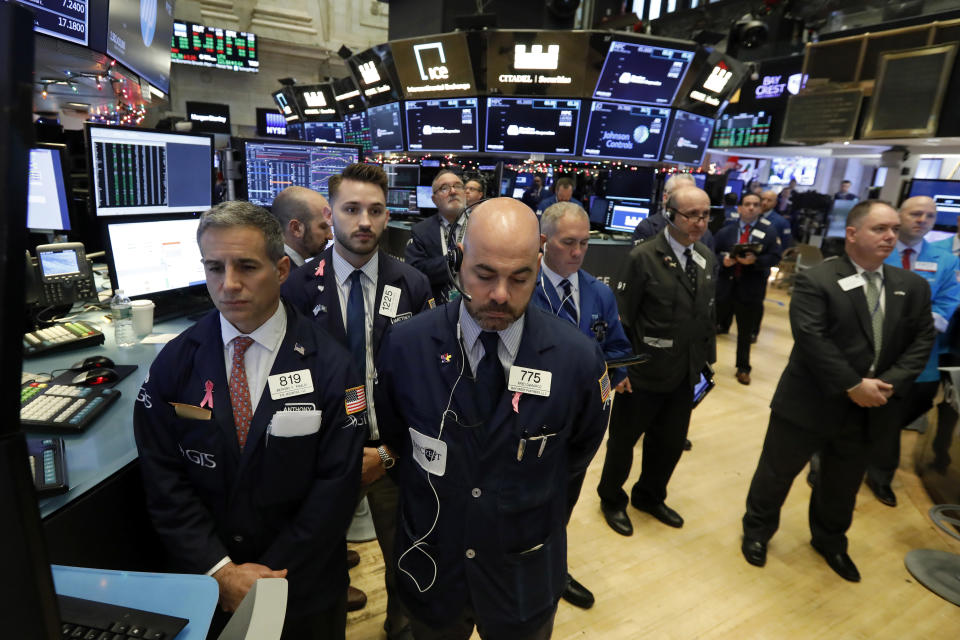Stock futures recover, markets close Wednesday
U.S. equity futures rose after a crushing session on Tuesday sent stocks plunging to their worst performance in nearly two months.
Futures for the S&P 500 (ES=F) rose 0.6%, or 16.25 points, as of 9:29 a.m. ET. Dow (YM=F) futures advanced 0.44%, or 110 points, after shedding nearly 800 points as of market close on Tuesday. Nasdaq (NQ=F) futures rose 0.66%, or 45 points.
On Tuesday, each of the three major indices closed lower by more than 3%. It was the worst session for the Dow and the S&P 500 since October 10, and the worst for the Nasdaq since October 24.
The rout that sent U.S. stocks reeling also engulfed markets overseas. As of 11:35 a.m. ET, the European FTSE 100 (^FTSE) and Stoxx 600 (^STOXX) were each down more than 1%. Japan’s Nikkei (^N225) and China’s Shanghai Composite (000001.SS) also slipped, while the Hong Kong Stock Exchange’s Hang Seng Index (^HSI) slid by more than 1.5%.
The numerical decline in stocks on Tuesday seemed harrowing, with the Dow lower by 799.36 points. However, the lost points tell only part of the story, as they have translated into smaller percentage declines over the years as the indices have gradually risen.
The first move of more than 500 points for the Dow took place on Oct. 19, 1987, with a 508 point drop representing a 22.6% decline for the index, Howard Silverblatt, senior industry analyst for S&P Dow Jones Indices, pointed out in a note. However, 500 points on Tuesday translated to just a 1.94% decline for the Dow, a percentage move that the index has experienced more than 2,000 times since 1896.
The Dow has moved lower by 1,000 points twice, with each occurrence taking place in 2018 and each translating to a more than 4% decline in the index. But even these quadruple-digit point moves do not register among the top historical percentage declines for the Dow. That title still goes to the session taking place on December 12, 1914, which saw a 23.52% change in the Dow with just a 16.8-point loss in the index. This century, the biggest percentage decline took place on October 15, 2008, which saw a 7.87% decline in the Dow on a 733-point loss.
Market closures on Wednesday
The U.S. New York Stock Exchange and Nasdaq are both closed on Wednesday to mark the day of mourning for the late former President George H.W. Bush, who died on November 30 at age 94. This is the first time the market closed for the death of a president since 2007 for former President Gerald Ford. Stock index futures will reopen Wednesday evening at 6 p.m. as usual.

The Securities Industry and Financial Markets Association (SIFMA), a financial-industry trade group, also recommended that fixed-income cash markets close on Wednesday, applying to securities including bonds and mortgage- and asset-backed securities.
CME Group, which operates an exchange for options and futures, will not hold trading for interest-rate and futures and options products. However, electronic trading and trading for energy and commodity futures will take place per the usual schedule.
Economic data previously scheduled for release on Wednesday will be moved to Thursday, including ADP’s report on national employment, the U.S. Commerce Department’s quarterly services survey, the U.S. Labor Department’s nonfarm productivity and cost data and the U.S. Energy Information Administration’s weekly petroleum status report. The Federal Reserve published its Beige Book on Wednesday at 2 p.m. as planned.
Corporate earnings originally scheduled for release Wednesday have also been pushed back. H&R Block (HRB) will report results before market open on Thursday. Lululemon Athletica (LULU) will release its third-quarter financial results after market close on Thursday. American Eagle Outfitters (AEO) will report results on December 11.
—
Emily McCormick is a reporter for Yahoo Finance. Follow her on Twitter: @emily_mcck
Follow Yahoo Finance on Twitter, Facebook, Instagram, Flipboard, LinkedIn, and reddit.
Read more from Emily:
Netflix user growth beats expectations, shares spike
Now is a ‘once-in-a-lifetime chance’ to invest in US pot companies, investor says
There are ‘4 headwinds’ facing markets rights now